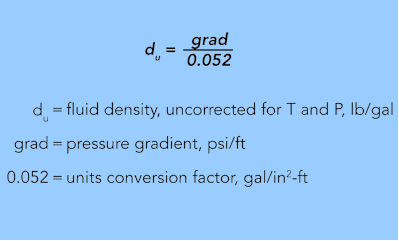Fluid Density
Expected bottomhole conditions are the basic criteria that influence the selection of a clear brine completion fluid. The fluid density required for a job is largely determined by the true vertical depth (TVD) planned for the well and the expected bottomhole pressure (BHP). True vertical depth is normally given in feet (ft), and bottomhole pressure is given in pounds per square inch (psi or lb/in2). These two values are used to determine the pressure gradient in pounds per square inch per foot of depth (psi/ft). An additional margin of safety should be added to the BHP to ensure that control of the well is achieved, usually 200 to 400 psi. The safe bottomhole pressure (noted as BHPs) and TVD are both used in Equation 1 to find the pressure gradient.
EQUATION 1.

The pressure gradient can be converted to density in pounds per gallon (lb/gal) by a change of units, shown in Equation 2.
EQUATION 2.

As an alternative, the values for TVD and BHPs can be used to find the required fluid density using Figure 3. This density value is the effective fluid density that will be required to balance the pressure exerted by the fluids in the formation. The colored regions in Figure 3 correspond to the fluid families: single salt, two salt, and three salt.
FIGURE 3. TVD-BHP Fluid Density Chart
General Fluid Density Ranges
Table 1 below provides an extensive list of conventional and specialty clear brine fluids and their working density ranges.
TABLE 1. General Density Ranges for Clear Brine Fluids
| Clear Brine Fluid | Density Range |
| lb/gal | |
| Ammonium Chloride, NH4Cl | 8.4 - 8.9 |
| Potassium Chloride, KCl | 8.4 - 9.7 |
| Potassium-Sodium Chloride, KCl/NaCl | 8.4 - 10.0 |
| Sodium Chloride, NaCl | 8.4 - 10.0 |
| Sodium Formate, NaO2CH | 8.4 - 11.1 |
| Potassium-Calcium Chloride, KCl/CaCl2 | 8.4 - 11.6 |
| Calcium Chloride, CaCl2 | 8.4 - 11.6 |
| Sodium Bromide, NaBr | 8.4 - 12.7 |
| Sodium Bromide-Chloride, NaBr/NaCl | 8.4 - 12.7 |
| Potassium Formate, KO2CH | 8.4 - 13.1 |
| Calcium Bromide, CaBr2 | 8.4 - 15.1 |
| Calcium Chloride-Bromide, CaCl2/CaBr2 | 11.6 - 15.1 |
| Potassium-Cesium Formate, KO2CH/CsO2CH | 13.1 - 19.2 |
| Cesium Formate, CsO2CH | 13.1 - 19.2 |
| Zinc Bromide, ZnBr2 | 15.2 - 20.5 |
| Zinc-Calcium Bromide, ZnBr2/CaBr2 | 15.0 - 20.5 |
| Zinc-Calcium Bromide-Chloride, ZnBr2/CaBr2/CaCl2 | 15.0 - 19.2 |
Density Ranges
There are many fluid options at the lower ranges of density, up to about 10.0 lb/gal. The choice of one brine over another may be based on unique formation properties. Bromide-chloride two salt fluids and formates reach densities up to 13.0 lb/gal. When the density requirement is more than 14.0 lb/gal, your selection is limited to two and three salt halides, zinc bromide (ZnBr2), and cesium formate (CsO2CH).
FIGURE 4. Clear Brine Fluid Density Ranges

